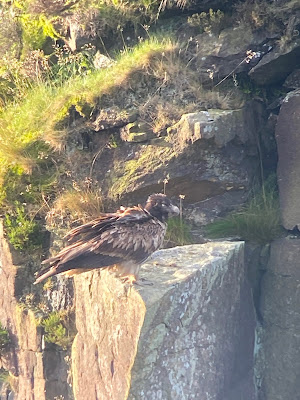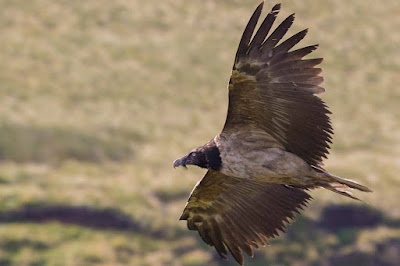The appearance of a young lammergeier in Gwent in summer 2016 came as a shock to Brit birders. For a few weeks it made sporadic appearances over Devon and Cornwall, and many of us made attempts to chase it down. Almost no one connected before it headed back over the Channel. Most of us assumed a reappearance anytime soon was unlikely.
It seems incredible to think of a wild vulture on our shores, but nevertheless there are several old records. I remember reading about them as a kid birder, in particular a famous Black Vulture in mid Wales in the 1970s which had been put down as an escapee. Some remained unconvinced by the escape ruling, citing the ancient records of other vulture species. It’s clear that, historically at least, vultures have occurred in the UK. A recurrence always seemed fanciful in my younger days; we live in an impoverished continent and populations had crashed. But conservation efforts begun in the mid eighties had started to pay off, and by the early 2000s Griffin Vultures begun to occur with increasing frequency just across the Channel. By the mid 2010s they were an annual occurrence and flock sizes numbered in the tens. Sometimes the regular Griffins were joined by a Black (now Cinereous) vulture. It was certainly on the cards.
Adding to the success of European vulture conservation, Lammergeiers were beginning to re-establish in the Alps after extirpation in the early 1900s. This massive and magnificent species has clung on in the Pyrenees, but elsewhere across the mountain ranges of Europe has fared very badly for the last century. As the 20th century progressed, scientists and ecologists begun to understand how vultures played a vital role in healthy montane ecosystems. Efforts to conserve and increase all species were commenced, which meant the start of a reintroduction programme to the Alps in 1986. Re-establishing such a large, slow breeding species is a gargantuan task. It was always going to take decades, but its worked and now the species is firmly back in the Alps. There’s lots of excellent information on the Vulture Foundation website (here). I’ve seen them whilst snowboarding, and also whilst on summer holiday in the Alps. As numbers continued to grow, wandering young lammergeiers have started to appear well away from the mountains across Northern Europe. These included released and wild born birds. Just as with the other vulture species, the appearances in Northern Europe were unexpected; was this a consequence merely of increasing populations and the natural wandering of youngsters, a reflection of changing climate, food shortages in our tidier environment or something else? No one knows.
In May 2020 a young lammergeier was photographed over the Channel Isles. It was even seen to head north into the Channel and there was brief hope that it would soon be in southern England, but shortly after it was back in France and moved eastwards and was seen in Germany and Belgium. It was photographed over Ghent on 20th June. Then, completely out of the blue, it was photographed over a garden in the West Midlands. Luckily the photographer realised it was something unusual and posted images on Twitter and broadcast to an astonished birding community. A few hours later it was seen heading north over the A50 in Staffordshire - surely it was headed to the South Peaks? Over the next few weeks it was reported sporadically, but the weather was poor and there were few eyes searching.
In the first week of July the net started to close in, tempting birders to put some time in, but efforts were scuppered by the Portland Shearwater. Then on Friday 11th July, with the appearance of some gripping images from near Derwent Reservoir and a reasonable forecast, a number of birders coordinated efforts in the area. After being off work on Wednesday I’d been unable to go. In the afternoon Dan Pointon, who else, picked it up across the reservoir. A few more connected, the rest of us watched with envy. Those on site thought it may have dropped in a remote clough, but couldn’t be sure. Despite having reasonable distant views, to their enormous credit, Dan and two others drove several miles round and then speculatively hiked up to the Abbey Brook clough and - remarkably - found the bird roosting on a cliff.
This was the opportunity we’d been waiting for. It remained on the rock until dusk. A dawn assault was required. So Malc, Mark, Phil and I met up at 2am, arriving in Strines an hour later to start the 1hr 45m steep uphill walk in the dark. Nightjars churred on the edge, grouse called from the keepered moor. It was a slog, but I really enjoyed the experience. The last few hundred meters meant leaving the track and crossing bog. Despite our early start it was well light by the time we arrived and around 30 people were already there. Just as we reached the group someone shouted - the Lammergeier was flying!
It's impossible not to be blown away by such an enormous bird. It was mobbed by tiny kestrels, just to add a little perspective. It drifted away down the valley, but thankfully was ever lost to view and it turned back, making a superb close pass before alighting on it's favoured ledge where it remained for the next hour or so and giving ridiculous views. It regurgitated some bones and flesh and proceeded to pick at these; Lammergiers are the only species on the planet with stomach acid sufficiently strong to dissolve bones. Once adults, bones form their exclusive diet, but young birds like this one are not yet able to do so, and scavenge instead.
This bird has, understandably, led to a great deal of interest from birds and the public alike. It settled in to the area and was visited by many hundreds over its lengthy stay. Naturally, there are very many images of this bird, almost all of which are better than mine!
Aside from the kestrels and the occasional buzzard, there were few birds up on the moor, although a Red Kite flew over at one point.











